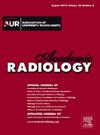Nomogram for Predicting Emergent Conversion to General Anaesthesia in Stroke Patients During Thrombectomy
IF 3.9
2区 医学
Q1 RADIOLOGY, NUCLEAR MEDICINE & MEDICAL IMAGING
引用次数: 0
Abstract
Rationale and Objectives
The aim of this study was to develop and validate a nomogram for predicting emergent conversion to general anaesthesia (GA) in stroke patients during thrombectomy.
Methods
In this retrospective study, 458 patients (320 and 138 were randomised into the training and validation cohorts) were enroled. Univariable and multivariable logistic regression analyses were employed to identify risk factors for emergent conversion to GA. Subsequently, a nomogram was constructed based on the identified risk factors. The discriminative ability, calibration, and clinical utility of the nomogram were assessed in both the training and validation cohorts using receiver operating characteristic (ROC) curve analysis, Hosmer–Lemeshow test, and decision curve analysis (DCA).
Results
The emergent conversion to GA occurred in 56 cases (12.2%). In the training cohort, four independent predictors of emergent conversion to GA were identified and incorporated into the nomogram: core infarct volume > 70 mL, severe aphasia, severe cerebral vessel tortuosity, and vertebrobasilar occlusion. The ROC curves illustrated area under curve values of 0.931 (95% CI: 0.863–0.998) and 0.893 (95% CI: 0.852–0.935) for the training and validation cohorts, respectively. Hosmer–Lemeshow testing resulted in average absolute errors of 0.028 and 0.031 for the two cohorts. DCA demonstrated the nomogram’s exceptional utility and accuracy across a majority of threshold probabilities.
Conclusion
The constructed nomogram displayed promising predictive accuracy for emergent conversion to GA in stroke patients during thrombectomy, thereby providing potential assistance for clinical decision-making.
预测脑卒中患者在血栓切除术中紧急转为全身麻醉的提名图。
依据和目的:本研究旨在开发和验证一个提名图,用于预测脑卒中患者在血栓切除术中紧急转为全身麻醉(GA)的情况:在这项回顾性研究中,共登记了 458 名患者(其中 320 名和 138 名被随机分为训练组和验证组)。采用单变量和多变量逻辑回归分析来确定急诊转为 GA 的风险因素。随后,根据确定的风险因素构建了一个提名图。使用接收器操作特征曲线分析、Hosmer-Lemeshow 检验和决策曲线分析(DCA)对训练组和验证组的提名图的判别能力、校准和临床实用性进行了评估:结果:56 例患者(12.2%)紧急转为 GA。在训练队列中,确定了紧急转为 GA 的四个独立预测因素,并将其纳入提名图:核心梗死体积 > 70 mL、严重失语、严重脑血管迂曲和椎基底动脉闭塞。ROC 曲线显示,训练组和验证组的曲线下面积值分别为 0.931(95% CI:0.863-0.998)和 0.893(95% CI:0.852-0.935)。Hosmer-Lemeshow 检验结果表明,两个队列的平均绝对误差分别为 0.028 和 0.031。DCA表明,在大多数阈值概率中,提名图都具有卓越的实用性和准确性:结论:所构建的提名图显示了对脑卒中患者在血栓切除术中紧急转为 GA 的预测准确性,从而为临床决策提供了潜在的帮助。
本文章由计算机程序翻译,如有差异,请以英文原文为准。
求助全文
约1分钟内获得全文
求助全文
来源期刊

Academic Radiology
医学-核医学
CiteScore
7.60
自引率
10.40%
发文量
432
审稿时长
18 days
期刊介绍:
Academic Radiology publishes original reports of clinical and laboratory investigations in diagnostic imaging, the diagnostic use of radioactive isotopes, computed tomography, positron emission tomography, magnetic resonance imaging, ultrasound, digital subtraction angiography, image-guided interventions and related techniques. It also includes brief technical reports describing original observations, techniques, and instrumental developments; state-of-the-art reports on clinical issues, new technology and other topics of current medical importance; meta-analyses; scientific studies and opinions on radiologic education; and letters to the Editor.
 求助内容:
求助内容: 应助结果提醒方式:
应助结果提醒方式:


